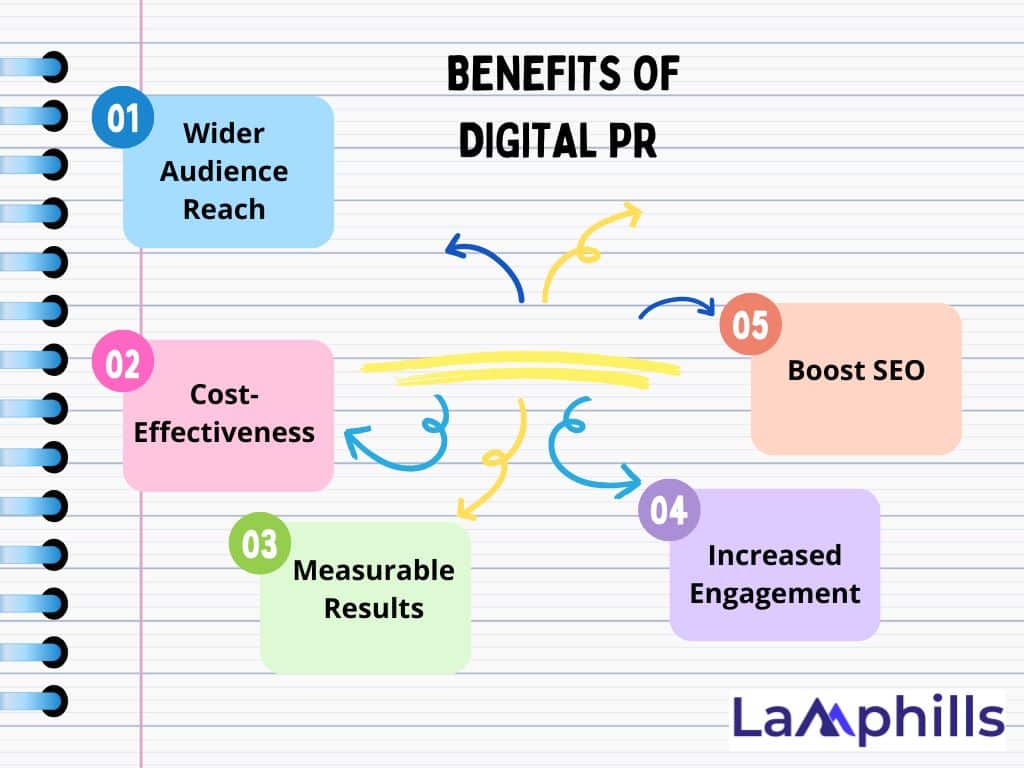Digital Public Relations (PR) Strategy is a way to make your brand more known using online channels. It’s like traditional PR, but it lets you reach more people in a way that you can measure and target better. To be effective, digital PR uses digital marketing techniques like search engine optimization (SEO), content marketing, influencer marketing, and social media.
When I first started learning about digital PR, I felt lost and not sure of where to begin. Luckily, my friend Lisa, who was an expert in the field, offered to help. Over coffee, I shared my struggles, and she invited me to her office the next day. Lisa patiently showed me how to build relationships with online influencers and create effective press releases. She also shared her favorite tools for tracking media coverage and measuring campaign success.
Thanks to Lisa’s guidance, I quickly grasped the basics of digital PR. I learned the importance of making shareable content, engaging with audiences on social media, and using analytics to improve strategies. What seemed difficult at first became an exciting challenge. This experience taught me not only about digital PR but also the value of having a mentor and sharing knowledge. Now, I’m excited to pass on these insights so others can also succeed in digital PR.
Key Points
- Digital PR is an online marketing strategy used to increase a brand’s presence by leveraging relationships with digital publications, bloggers, and influencers. It helps brands earn high-quality backlinks, improve visibility on search engines, and reach a wider audience.
- Beyond just increasing brand awareness, Digital PR offers many advantages, it helps create meaningful connections with your audience and delivers real results. Other benefits include; a wider Audience Reach, Cost-Effectiveness, Measurable Results, Increased Engagement, Boost SEO
- There are various strategies to boost your brand’s online presence and reputation, it includes; Media Relations, Content Marketing, Influencer Outreach, Social Media Management, Online Reputation Management (ORM), Guest Blogging, Digital Press Releases, and others
What is Digital PR
Digital PR stands for Digital Public Relations. It’s a way of promoting brands online to make them more well-known and visible. The main aim of digital PR is to improve a brand’s image and presence on the internet. This is done by increasing mentions on social media, getting more links from other websites, and boosting the number of visitors who come from other sites.
Unlike traditional PR, which focuses on print media, TV, and radio, digital PR focuses heavily on SEO and online engagement metrics, using blogs, social media, and websites to build your brand, enhance your reputation, and engage your target audience with compelling content.
Digital PR is a strong strategy that helps companies talk directly to their target audience anytime and anywhere. By connecting with your audience and sharing information, you can start a conversation that clarifies your goals and spreads news quickly.
From my experience using Digital PR, I have seen so many benefits of Digital PR as against using the traditional method. But I will share some notable benefits of Digital PR in this guide.
Read Also: Top 12 Digital PR Agencies Worldwide + Free Strategies
Benefits of Digital PR

Beyond just increasing brand awareness, Digital PR offers many advantages, it helps create meaningful connections with your audience and delivers real results. Here are some key benefits:
#1. Wider Audience Reach
One of the biggest benefits of digital PR is the ability to engage with a global audience in real time. Unlike traditional PR, which often focuses on local or regional reach, digital PR can cross geographical boundaries. Brands can share their stories and news worldwide through online platforms, increasing brand exposure and allowing connections with diverse markets and demographics.
#2. Cost-Effectiveness
Digital PR is usually more cheap compared to traditional PR methods. Traditional PR often involves expensive advertising space, print ads, and large-scale events. Digital PR, on the other hand, uses affordable online tools and platforms. Sharing content on social media, blogs, or digital platforms is often cheaper, making it accessible for small businesses to run impactful campaigns and compete effectively with larger brands.
#3. Measurable Results
A significant advantage of digital PR is the ability to monitor and measure results in real time. Unlike traditional PR, which can be difficult to track, digital PR provides clear metrics through tools like Google Analytics, social media analytics, and SEO software. These tools help brands track website traffic, engagement levels, and conversion rates, allowing for strategic adjustments and continuous improvement.
#4. Increased Engagement
Digital PR encourages direct and meaningful interactions with your audience. Social media channels allow brands to respond to comments and participate in conversations, building trust and loyalty. Engaging content like blog posts, social media updates, and interactive videos helps audiences form deeper connections with the brand, fostering stronger and longer-lasting relationships.
#5. Boost SEO

Digital PR positively impacts search engine optimization (SEO). High-quality content and backlinks from reputable websites can improve search engine rankings, leading to greater visibility and increased organic traffic. Effective digital PR strategies focus on creating engaging content that attracts links, boosts domain authority, and helps the brand climb search engine results pages, positioning it as a reliable and authoritative source in its industry.
Read Also: Digital Workspace: Benefits And What It Entails
Types of Digital PR Strategies
There are various strategies to boost your brand’s online presence and reputation. Here are some of the most effective ones:
#1. Media Relations
Media Relations in Digital PR involves building strong relationships with journalists and bloggers to get your company’s news and stories featured in online publications. By maintaining good connections with these media professionals, you can secure valuable coverage that reaches a wide audience. This type of PR helps to enhance your brand’s credibility and visibility, making it more likely that potential customers will hear about your business.
It involves regularly sending press releases, pitching story ideas, and responding to media inquiries on time. Successful media relations can result in positive articles and mentions that boost your brand’s reputation and online presence.
#2. Content Marketing

Image by rawpixel.com on Freepik
This is a type of Digital PR where you create and share useful and interesting content to attract and engage your audience. This content can include blog posts, videos, infographics, and ebooks that provide valuable information. The goal is to offer something helpful to your audience, which can build trust and encourage them to learn more about your business.
By consistently providing quality content, you can improve your online presence and attract potential customers. Overall, content marketing helps establish your brand as a reliable source of information in your industry.
#3. Influencer Outreach
Work with influencers to promote your brand to their followers. Influencers can help you reach a specific audience, enhancing your brand’s trustworthiness and visibility.
Influencer outreach is a Digital PR strategy where companies collaborate with popular social media personalities to promote their products or services. These influencers have a large number of followers who trust their recommendations. By partnering with them, businesses can reach a wider audience and gain more visibility. This method leverages the influencer’s credibility to build trust with potential customers. It is an effective way to increase brand awareness and drive sales through authentic endorsements.
#4. Social Media Management
This involves actively maintaining and updating your business’s social media profiles on platforms like Facebook, Twitter, and Instagram. It includes creating and sharing engaging content, such as posts, photos, and videos, to attract and retain followers. Engaging with your audience by responding to comments, messages, and reviews is a key part of building a loyal community.
Regularly analyzing performance metrics helps you understand what content works best and how to improve your strategy. This type of Digital PR helps increase brand awareness, foster customer relationships, and drive more traffic to your website.
#5. Online Reputation Management (ORM)
This is about controlling how your business is seen on the internet. It involves monitoring mentions of your brand across various online platforms to ensure a positive image. This can include responding to customer reviews, addressing negative comments, and promoting positive content about your company.
By managing your online reputation, you can build trust with your audience and attract more customers. Effective ORM helps maintain a good relationship with your customers and protects your brand’s image.
#6. Guest Blogging
Guest blogging is when you write articles for other websites instead of your own. This helps you reach new audiences and attract more people to your website. By contributing valuable content to reputable sites, you can establish yourself as an expert in your field. It also builds backlinks to your website, which improves your search engine rankings. Overall, guest blogging is a powerful way to enhance your online presence and grow your brand.
#7. Digital Press Releases
These are official announcements shared online to inform the media and the public about important news from a company. They are written articles that provide details about new products, company milestones, events, or significant achievements. These press releases are distributed to various online platforms, including news websites, blogs, and social media, to reach a wide audience.
By sharing timely and relevant news, digital press releases help build credibility and generate publicity for the company. They also improve search engine visibility by creating backlinks to the company’s website.
#8. Community Engagement
Participate in online communities like forums and groups related to your industry. This helps build a positive brand image and connect with a loyal audience by sharing valuable insights.
Community engagement in Digital PR involves actively participating in online communities where your audience gathers. This includes forums, social media groups, and other online platforms where people discuss topics related to your industry. By joining these conversations, you can share valuable insights, answer questions, and build relationships with potential customers.
Engaging with the community helps establish your brand as a helpful and knowledgeable presence. It also fosters trust and loyalty, making people more likely to support and recommend your business.
#9. Podcast and Webinar Participation

This is a powerful type of Digital PR where you share your knowledge and expertise with a wide audience. By being a guest on podcasts, you can discuss industry trends, share tips, and promote your business to the podcast’s listeners. Hosting or participating in webinars allows you to give detailed presentations, answer questions, and interact directly with attendees. This not only positions you as a thought leader in your field but also helps build trust and credibility with potential customers. Overall, it’s an effective way to reach new audiences and establish your brand’s authority online.
#10. Email Marketing
In email marketing, businesses send targeted emails to their customers to keep them updated and engaged. It involves sharing news, promotions, and updates directly to the inbox of the audience. This helps maintain a strong relationship with customers, reminding them of the brand and its offerings.
Through personalized and relevant content, email marketing can encourage repeat business and foster loyalty. It’s an effective way to communicate directly with your audience and keep them informed about what’s happening with your business.
These types help create a positive online image, attract new customers, and improve your brand’s visibility on the internet.
Developing a Digital PR Strategy
Starting a digital PR strategy is essential for building your brand online. Whether you do it yourself or hire an agency, taking the first steps will help you see what works and what doesn’t, allowing you to make adjustments as needed.
Step 1: Define Your Goals
My first experience with digital PR was a campaign for a small startup. We wanted more people to know about our brand and visit our website. Setting clear goals was very important. Whether you want to make your brand more visible, get more website visitors, or improve your search engine rankings, having a clear goal helps you plan your strategy and see how well it works.
Step 2: Know Your Audience
After setting your goals, the next step is to know who you are trying to reach. Your audience could be the media, the general public, or other important groups depending on your campaign.
Creating detailed audience profiles helps you understand your ideal customer better. These profiles include basic information like gender, age, job, and education. However, it’s also important to know what your customers are interested in, what they value, and how they see the world. The more details you have, the more successful your online PR campaign will be.
I once worked with a fashion brand for young adults. We did a lot of research to learn what they liked, how they behaved, and which social media platforms they used. With this information, we created content that spoke directly to them, which led to better engagement and more sales.
Step 3: Craft Compelling Content
Digital PR content can be articles, press releases, videos, infographics, and podcasts. You can figure out which type of content your audience will like by using your ideal customer profiles.
The success of your digital PR campaign depends on the content you create. For example, media companies prefer campaigns with data, statistics, and insights. Major publications are more likely to share your content if it includes groundbreaking research with stats and quotes from industry leaders. Data-driven content is also a good way to get high-quality links from top websites.
Good content is very important in digital PR. For a tech company campaign, we made high-quality, helpful content that solved our audience’s problems. We used blog posts, infographics, and videos to share our message. Always make sure your content is useful, interesting, and easy to share.
Step 4: Use Social Media
Using social media is key to building a strong digital PR strategy. It helps you share your content with a wider audience quickly. By engaging with followers and posting regular updates, you can create a community around your brand. Additionally, using hashtags can make your content more discoverable to new people.
For an e-commerce client, we used Instagram and Twitter to share our content. By interacting with followers, posting updates, and using hashtags, we reached more people and created a community around the brand.
Step 5: Connect with Influencers
Connecting with influencers is an important part of a Digital PR strategy. Influencers have large followings and can help spread your message to a wider audience.
By partnering with influencers who align with your brand, you can boost your online visibility and credibility. Their endorsements can lead to more traffic to your site and higher sales. I recall teaming up with a popular tech blogger for a product launch. Their support not only enhanced our credibility but also led to significant traffic and sales.
Step 6: Optimize for SEO
SEO and PR work hand in hand. Optimizing for SEO is crucial in a digital PR strategy. It involves using the right keywords so that your content appears higher in search engine results. By doing this, more people can find and read your content. This helps to increase your online visibility and attract more visitors to your website.
Step 7: Monitor and Measure
It’s important to keep track of and measure your PR efforts to keep getting better. This step involves tracking the performance of your PR activities to see how well they are doing. By looking at metrics like website traffic, social media engagement, and media coverage, you can understand what is working and what needs improvement. Regularly analyzing this data helps you adjust your strategy to achieve better results.
Tools like Google Analytics, SEMrush, and social media analytics give you useful information about how your campaigns are doing. In one campaign, we saw that our blog posts were getting the most attention, so we focused on making more blog content.
Making a good PR plan might seem like a lot of work, but it’s easier if you take it step by step.
How to Measure the Success of a Digital PR Campaign
Digital PR is great because you can track and measure its success. This lets you see which campaigns or messages are effective and which are not.
Key metrics to track include:
- Clicks: Track links in articles or posts to see how much activity they generate.
- Links: Count the number of links your content received and evaluate their quality.
- Social Shares: See how many times your campaign or article was shared on social media and by whom.
- Leads or Revenue: Determine if any leads or revenue can be attributed to your campaign using tools like Google Analytics.
- ROI: Assess the return on investment (ROI) by looking at visibility, web traffic, brand sentiment, or revenue increases.
Your digital PR strategy should focus on providing valuable and informative content to your audience. Make sure your content aligns with your overall content pillars and SEO strategy.
Steps to Boost Your Online Presence
#1. Use User-Generated Content: Encourage your customers to share their experiences with your brand on social media. This not only boosts your online presence but also builds trust and authenticity.
#2. Join Online Communities: Take part in forums, groups, and discussions related to your industry. Sharing helpful tips makes you look like an expert and brings more visitors to your website.
#3. Use Visuals: Add images, videos, and infographics to your content. These are engaging and easy to share, which helps catch your audience’s attention and boosts your online visibility.
#4. Guest Blogging: Write guest posts for well-known blogs and websites in your field. This gives you valuable backlinks and introduces your brand to more people.
#5. Monitor Online Reputation: Use tools like Google Alerts and Mention to keep track of what people are saying about your brand online. Respond quickly to reviews and feedback to keep a positive reputation.
Some Digital PR Tools
To run a successful PR strategy, you need the right tools to stay organized, measure results, and improve your efforts. Here are some important tools that can boost your online PR work:
Here’s a checklist below on what to look out for when choosing digital PR tools, to help you make better choices that fit into your PR goals.
1. BuzzSumo
What it does: BuzzSumo helps you find popular content and trends online. You can see what topics are getting the most attention and which influencers are sharing them.
Why it’s useful: It lets you know what people are talking about and helps you create content that will get noticed.
#2. HARO (Help A Reporter Out)
What it does: HARO connects journalists with experts who can provide information for their stories. You can sign up to get daily emails with opportunities to share your expertise.
Why it’s useful: It gives you a chance to get featured in media outlets, increasing your visibility and credibility.
#3. Google Alerts
What it does: Google Alerts sends you emails when new content about your chosen keywords appears online. You can track mentions of your brand, competitors, or industry news.
Why it’s useful: It keeps you informed about what’s being said about you or your industry, allowing you to respond quickly.
#4. Moz
What it does: Moz offers tools for improving your website’s search engine ranking. It helps you find the best keywords, track your website’s performance, and see how your competitors are doing.
Why it’s useful: It helps you optimize your website to attract more visitors and improve your online presence.
5. Hootsuite
What it does: Hootsuite lets you manage all your social media accounts in one place. You can schedule posts, track engagement, and analyze performance.
Why it’s useful: It saves time and helps you stay organized with your social media efforts, making it easier to engage with your audience and measure results.
Practical Example of Companies that used Digital PR Strategy
Here are notable companies that have successfully used Digital PR strategies:
Coca-Cola

Coca-Cola encourages customers to share their moments with Coke products using specific hashtags, like #ShareACoke. They also feature user-generated content in their marketing. This strategy not only increases brand engagement but also creates a sense of community among consumers.
Airbnb
Strategy: Storytelling and Social Media Engagement
Airbnb uses captivating stories about unique travel experiences shared by its users. They also engage with their audience on social media platforms like Instagram and Twitter. This approach helps them create a community and build trust with potential customers.
Nike

Strategy: Influencer Collaboration and Social Campaigns
Nike partners with popular athletes and influencers to promote their products. They also launch impactful social campaigns, such as “Just Do It,” which resonate with their audience and gain widespread media coverage. This strategy boosts their brand visibility and credibility.
Spotify
Strategy: Data-Driven Campaigns
Spotify uses data from user listening habits to create personalized and shareable content. Their “Wrapped” campaign, which shows users their yearly music statistics, is a hit on social media and generates a lot of organic buzz. This clever use of data helps Spotify stay relevant and engaging.
These companies use Digital PR strategies to connect with their audiences, build their brands, and enhance their reputations through engaging and shareable content.
Wrap Up
In summary, Digital PR is always changing, so you need to plan well and keep adjusting. To succeed, set clear goals, know your audience, create engaging content, use social media, build relationships with influencers, optimize for search engines, and track your progress. The keys to success are being consistent, creative, and up-to-date with the latest trends.
Ready to boost your brand with digital PR? Start now and watch your online presence grow!
Frequently Asked Questions.
What’s the Difference between Digital PR and Traditional PR?
Traditional PR focuses on getting coverage in print media like newspapers, magazines, and TV. It relies on press releases, events, and direct outreach to the media. Digital PR, on the other hand, shifts to the online world. It uses blogs, social media platforms, and online publications. The main differences are in speed, outreach, and engagement. Digital PR allows for quick communication and interaction, creating a lively connection between brands and their audiences.
How do I come up with a digital PR idea?
You can’t create a good public relations campaign without knowing who it’s for. Understanding your audience helps you stay focused and relevant. When you know what your audience likes and needs, you can make sure your ideas fit them well. This makes your content more meaningful and effective.
Is digital PR an SEO?
Digital public relations (PR) isn’t the same as SEO, but it can help with SEO a lot. Digital PR is a marketing method that uses online platforms to boost a brand’s visibility and reputation. It can enhance a brand’s expertise, authority, and trustworthiness (E-A-T), supporting SEO efforts. Digital PR can also create high-quality backlinks, leading to more organic links and better search engine rankings.
What is the difference between digital PR and online PR?
Online public relations (PR), also called digital PR or E-PR, is a way to use the Internet to talk to potential and current customers. The goal is to build a good image for a company or brand by shaping online discussions about the organization, its products, and its services.
Related Articles
13 Digital Storytelling Examples that Will Inspire You
What a PR Strategist Really Does: (+ Free Helpful Tips)






